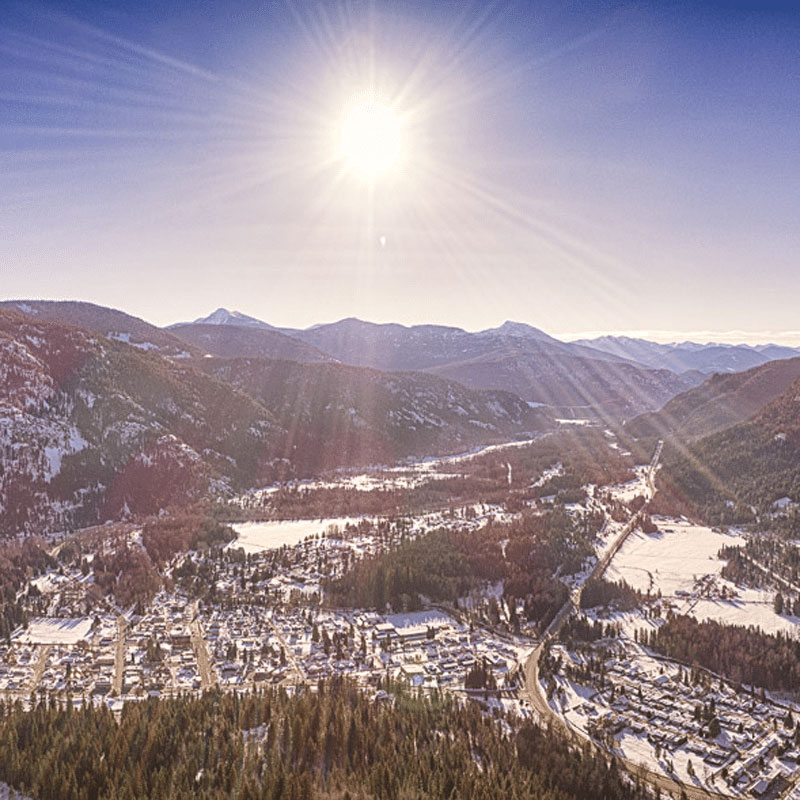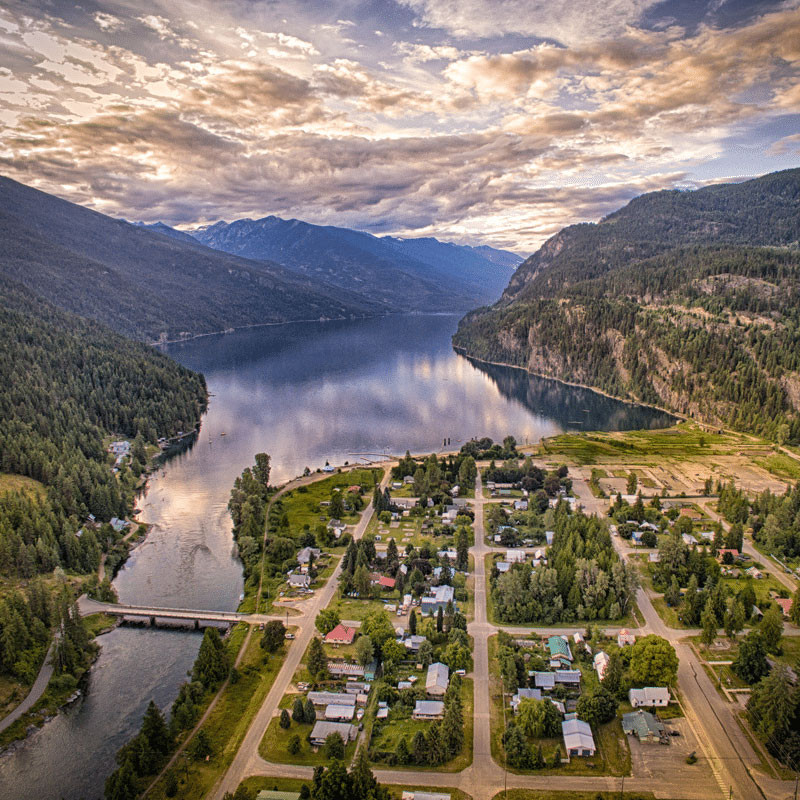Our Communities
Creston
The Town of Creston sits in the rich, wide valley between the Purcell and Selkirk Mountain Ranges in the Purcell Trench at the base of the Skimmerhorn Mountains with the Kootenay River draining into Kootenay Lake. The original inhabitants of the region were the Kutenai – one of three groups who formed the Ktunaxa First Nation. The first European known to have come to the area was the British explorer and geographer, David Thompson, after having crossed the Rockies in mid-winter with his indigenous wife and two small children in 1807. Other explorers and prospectors followed seeking precious metals and settlement of the area began.
The Creston Valley’s economy today is fueled mostly by agriculture and forestry, with many residents working in government services, education, and significant growth in the tourism and hospitality sector. The Columbia Brewery, producer of Kokanee Beer and Kootenay Ale is a significant employer and, in addition to the fruit and vegetable harvests, the area is seeing an increasing number of vineyard plantings and wine production.
- Population (2016 est.):
5,351 - Age Demographic Profile:
Children (0-14 years):580.
Emerging Labour Force (15-24 years): 430.
Primary Labour Force (25-64): 2,370.
Seniors (65+): 1,975 - Primary Industry:
Sales and Service
Healthcare
Social and Gov’t Services
Agriculture
Education
Trades, transport & equipment ops - Major Employers:
School Dist. # 8
Columbia Brewery
JH Huscroft Ltd.
Interior Health Authority (regional)
BCGEU (regional)
RDCK (regional)
Nelson

The City of Nelson is situated at the junction of provincial Highway 3A and Highway 6 on the shores of Kootenay Lake, one of the largest and most beautiful lakes in BC. Though the economy was at one time based on forestry and mining, this is less and less true. Tourism, recreation, hospitality and retail sales now also play major roles. Nelson has also emerged as the provincial administrative center for the Kootenays.
The city is known as a “hotbed“ for entrepreneurs and knowledge workers as well as for local and organic food and product producers (and consumers). Perhaps as a result of all this activity, Nelson also has a cost of living, and housing, higher than any other community in the region. This is a challenge is met by job seekers, employers and residents alike—all of whom appreciate its thriving arts and culture scene and its world class recreational opportunities.
- Population (2014 est.):
10,532 – 16,704 (including RDCK Areas E & F) - Age Demographic Profile:
Children (0-14 years):1620.
Emerging Labour Force (15-24 years): 1245.
Primary Labour Force (25-64): 5790.
Seniors (65+): 1575 - Labour Force:
Labour Force participation rate: 59.3% (Kootenay Region) Average Income: $37,541/year (88.4 % of BC Average) Source: CRA 2014 - Primary Industry:
Healthcare
Social and Gov’t Services
Tourism and Hospitality
Retail Sales
Financial Services
Construction/Paving
Emerging Tech and Knowledge sector - Major Employers:
Interior Health Authority (regional)
FortisBC (regional employer)
BCGEU (regional employer)
Golden Life (regional employer)
SD8
Whitewater Ski Resort
Selkirk College (regional)
City of Nelson
Hume Hotel/Best Western
Walmart
Canada Safeway
Kootenay Country Food Co-Op
Maglio Building Centre
YRB (Yellowhead Road and Bridge)
Nelson and District Credit
Kaslo

The Village of Kaslo, with a population of about 1,000, is the largest community on the main body of Kootenay Lake. Looking east across the lake, residents enjoy breathtaking views of the Purcell Mountains and the iconic Mt. Loki. Like with most of the West Kootenays, mining and forestry used to provide most of the jobs in Kaslo—and that situation is changing.
The village is home to people with a wide variety of skills and talents, many of whom are there to be close to nature and away from the buzz of cities. Kaslo is a haven for arts and recreation, and is committed to developing jobs in the tech and knowledge sector.
- Population (2014 est.):
1,008 – 2,597 (including RD Area D) - Major Employers:
Interior Health Authority
SD8
Kaslo Building Supplies
Kaslo Hotel and Pub
Kaslo Motel
Kaslo Shipyard
Retallack Lodge
Kaslo Golf Club
Honey Candles Ltd
Jones Boys Boats
Selkirk Wilderness Skiing
Stellar Skiing
Pennywise
Kootenay Savings Credit Union
Front St Pizza
Cornucopia
Kaslo Community Pharmacy
Ainsworth Hotsprings
Salmo

The Village of Salmo is another small community served by KCDS. Situated in the beautiful Selkirk Mountains of southeastern British Columbia, Salmo is an equal 30-minute drive from Nelson, Castlegar, and Trail. This makes for an easy commute to regional employment options. Salmo’s roots are in mining and forestry, but, like the whole region, the community is evolving and trying to diversify into other areas.
Home to a community ski hill, a golf course and the annual Shambhala Music Festival, the village has something for everyone—year-round. Their Official Community Plan outlines three major economic development objectives: encouraging industries of a non-polluting nature to locate there, promoting the advantages of Salmo’s location, and encouraging multi-level educational opportunities.
- Population (2014 est.):
1187 – 2,612 (including RDCK Area G) - Major Employers:
Interior Health Authority
SD8
Porcupine Wood Products Ltd
Kootenay Savings Credit Union
Shop Easy
Salmo Foods
Esso
Subway
Slocan

The Village of Slocan is in the Slocan Valley, beneath the big peaks of Valhalla Provincial Park, where Slocan Lake turns into Slocan River. With the closing of the Springer Creek Forest Products sawmill, the Village of Slocan and area lost around 175 well-paying jobs. As is often the case in communities where the primary employer shuts down, the people of the area have had to reinvent themselves and diversify. This makes for a dynamic environment, full of potential.
Though forestry stills provides many jobs for the village and area residents, eco-tourism, growing and selling local food, and work in technology are all contributing to the village’s evolution. New housing starts, population and business development are on the rise—all indicators of positive growth.
- Population (2014 est.):
301 – 5275 (including RDCK Area H) - Major Employers:
Interior Health Authority
SD8
YRB (Yellowhead Road and Bridge)
Sockeye Enterprises
Slocan Village Market
Harold St Café
Flaca’s Bistro
Mountain Valley Station
WEGCSS
Village of Slocan
Ice Creek Lodge
Weir Dough’s Woodfire Bakery
MamaSita’s Cafe
Sleep Is For Sissies
SIFCO
Community Resources
The FETCH site provides information about programs and resources located in, or serving, communities in the Kootenay Boundary Region.


